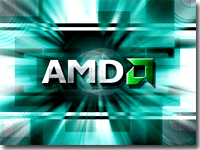AMD Reports Quarterly Earnings for Q2 2011
AMD yesterday followed a slew of companies announcing quarterly financial results and revealed the closing figures for its own Q2 2011.
AMD today announced revenue of $1.57 billion for the second quarter of 2011, a two percent sequential decrease and a five percent decrease year-over-year. Net income was $61 million while earnings per share (EPS) and operating income were $0.08 and $105 million, respectively. This is compared with a net income of $43 million or $0.06 per share for the same period in 2010 and $510 million or $0.68 per share for Q1 2011. AMD posted a non-GAAP net income of $70 million, and non-GAAP EPS and operating income were $0.09 and $114 million respectively.
AMD also talked about what it wants for the upcoming quarter, revealing that it expects to see revenue increase 10 percent, plus or minus two percent, sequentially for the third quarter of 2011. Bloomberg reports that the average analyst is predicting eight percent revenue growth for AMD in the next quarter.
"In the first half of 2011, AMD brought to market the most competitive client offerings in our history, reinforcing our position as a design and innovation powerhouse," Thomas Seifert, CFO and Interim CEO, said via statement yesterday "Today's computing experience is increasingly being defined by the ability to deliver brilliant multimedia and video content with all day battery life. Fusion APUs are ideal to meet this need, positioning AMD to gain unit market share in the mobile computing space."
AMD is still actively looking for a new Chief Executive Officer and Harry Wolin, senior vice president and general counsel at AMD, yesterday said that while finding a CEO is still top priority, the company is taking time to search for the best candidate as opposed to finding someone to fill the spot ASAP.
Get Tom's Hardware's best news and in-depth reviews, straight to your inbox.

Jane McEntegart is a writer, editor, and marketing communications professional with 17 years of experience in the technology industry. She has written about a wide range of technology topics, including smartphones, tablets, and game consoles. Her articles have been published in Tom's Guide, Tom's Hardware, MobileSyrup, and Edge Up.
-
AMD still going the wrong direction. I just sold a AMD Fusion based small Notebook with a E350 APU. Sure it had good graphic performance but what it gained in graphics it lost in CPU performance. Its like getting a bionic leg and still missing the other leg? Not many are being fooled by AMD's remaining its lineup to Fusion. Its sounds catchy but says nothing about how that helps the user? I don't see that AMD is really advancing and basically has just gone to combining chips (graphics and CPU) into one which has lowed the power consumption. But really has not helped either do better against Intel in real world use.Reply
-
geekapproved The future is low power cpu/gpu and AMD trumps Intel by far in GPU. Expect cpu/gpu/arm on some upcoming AMD chips. This is the right direction. The right direction is not taking on Intel high end cpu's, but take it to them in the emerging markets, smartphones, pda's, tablets, etc.Reply
Desktop is dying fast. -
runswindows95 Actually, the Llanos are perfect for real world use. The majority of PC's owners mostly use their systems to browse the web, email, word processing, tasks that really don't need a high end CPU. They do not play the newest games at the highest settings or convert video files 24/7. It's a decent CPU with the best integrated GPU on the market right now. Considering you can now buy a $400 to 500 computer (desktop or laptop) that can double as a light gaming system or a great HTPC, I say AMD is going in the right direction. Personally, for my next laptop I'm looking at the Llano's for all I do is word processing, watch online videos, and play mp3's. You can't get more real world usage than that.Reply -
Soma42 For the masses, AMD is going all in the right direction. I have to hope that Bulldozer is the success it's hyped up to be so that Trinity can be all that it's hyped up to be. Plus, it's good for competition and that's something sorely needed these days.Reply
My next laptop will probably have trinity in it, which is supposed to be 50% faster than Llano, and if I ever getting around to building a HTPC it will have the non-mobile version. -
jescott418: This isn't 1995, back when everyone could use a faster computer. Here's how it breaks down:Reply
50% of users could get by fine with an e350 and not notice the "slow CPU"
90% of users could get by fine with Llano and not notice the "slow CPU" or "slow GPU"
5% of users actually need a powerful discrete GPU to do their uber-gaming
5% of users need epic amounts of CPU power for intensive rendering tasks
It's the same Intel fanboys who claim that Sandy Bridge supposedly beating Phenom II by 10-20% in real life is actually noticeable, are the same ones who claim Llano's GPU beating SB by 100-200% isn't noticeable.
The bottom line: Llano is capable of doing things SB is not, SB is not capable of doing anything Llano isn't. Yet the paid Introlls like Anand state that Llano has "too much GPU", and SB is "balanced". -
Llano is the perfect chip for the vast majority of my customers needs, just quoted up a HTPC with HVR 4400 tuned card, A8 and Asus board, probably the best product to Come from AMD yet, they should gain share from this for sure.Reply
-
amk-aka-Phantom GeekApprovedDesktop is dying fast.Reply
My Core i7 rig disagrees. It doesn't think that Llano and lower power CPUs/GPUs can be better than it.
When these low power chips will be enough to play the latest games while converting videos and installing programs on the background, I'll buy them. Until then, I'll only build low-power boards based PCs as part of my job and for fun. Thinking of getting a solid mini-ITX or micro-ATX build just to play around with it... no real use whatsoever in the low-power stuff.
llano_buyerThe bottom line: Llano is capable of doing things SB is not, SB is not capable of doing anything Llano isn't. Yet the paid Introlls like Anand state that Llano has "too much GPU", and SB is "balanced".
Troll much? Onboard GPUs are USELESS. For office tasks, HD video and YouTube the Intel 945G onboard graphics were more than enough (those who can't watch HD with that just don't know how to setup the codecs, I guarantee that). Adding GPUs into CPUs is just a marketing trick. 90% of the people who use Sandy Bridge (except i3) don't use its internal GPU and get dedicated graphics. I don't care whether Llano's GPU is better than SB's, I've got a GTX 560 Ti. If I ever buy I computer that is NOT meant for gaming, I won't care what kind of IGP it has, because I know ALL modern IGPs can do office, HD and so on.
And don't tell me that 90% of the users won't notice a slow CPU... part of my job is to help keep many networks in our town running, and many of them are based on Linux... Atoms and other "low-power" stuff really suffers there, especially on thin clients. Not saying that they should use i7-990X or i5-2500K there to improve their performance, but I usually talk people out of getting low-power boards and convince them to get something like Core 2 Duo or Core i3, even for office purposes (not just Linux-based).
And don't get me wrong, I like AMD... their graphics kick some serious ass and they were my favorite back in the days when they kicked Intel's Pentium 4, but I feel like they ARE taking a wrong route here. If at all, they should go for SERIOUS low-power, meaning phones/tablets/netbooks. However, low-power in desktop? I laugh at this.
Actually, might be useful if you're running a lot of computers and you're very limited on electricity - like power cuts all the time, and a battery backup room that can only supply electricity for a few hours; then low-power stuff will last longer. But where do you find that, except Asia? :D -
ta152h I'm in agreement with those that think Bobcat is a promising technology, but AMD screwed up by making the GPU in it too strong. It's probably a power play by a weakling, and will not work. Obviously, they are trying to get software developers to see the unused resources of the GPU, and start using them for computing. If this happened, AMD would benefit greatly, but it is a Catch-22, since they aren't big enough to do it. It's another 3D Now!.Reply
They should halve the GPU, and save some money. Too weak a CPU, and too poor memory for that GPU. Halve it, and you'll have a nice balance that will cost less and use less power, and do what 95% of the people need it to do. Getting a new programming model is beyond AMD's ability.
